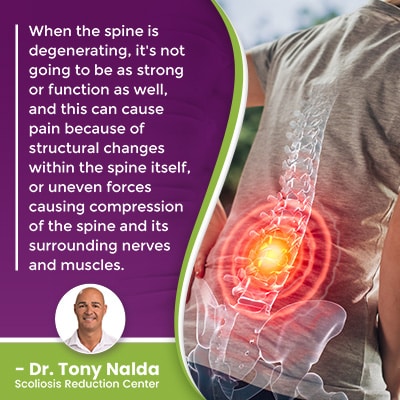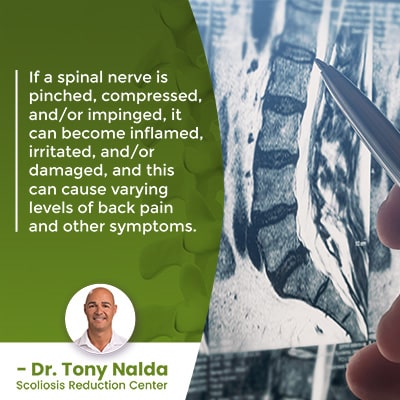Spine Anatomy Overview: What Causes Back Pain?

The body is subject to degenerative changes with age, as is the spine. The most common cause of back pain is spinal degeneration, and spinal degeneration can also lead to the development of a number of spinal conditions/issues also capable of causing varying degrees of back pain. Back pain can involve a structural issue with the spine itself, muscle issues, and/or radiating pain due to spinal-nerve compression.
The spine is a complex structure with many moving parts; in fact, the design of the spine is movement-based, which is why staying active is so important for spinal health. Back pain can have a number of causes from not leading a spine-friendly lifestyle to spinal degeneration and the development of painful spinal conditions.
Let's start our exploration of back pain by discussing the basic anatomy of a healthy spine.
Table of Contents
Anatomy of a Healthy Spine
A healthy spine has its natural curves in place and its vertebrae are aligned as they should be.
When looking at a healthy spine from the sides, it will appear to have a soft 'S' shape, and when looking at it from the front and/or back, it will appear straight, and this is due to the spine's natural and healthy curves.
The spine is naturally curved because it makes it stronger, more flexible, and better able to absorb and distribute mechanical stress incurred during activity, somewhat like a coiled spring.
The spine consists of vertebrae (bones) that are rectangular in shape so they can be neutrally stacked on top of one another, and each pair of adjacent vertebrae are separated by an intervertebral disc, and these discs are key to spinal strength, health, and function, which we'll explore more shortly.
The spine has three main sections, and each has unique roles to play in preserving spinal health and function.
The cervical spine consists of the neck, and it connects the brain to the rest of the body, has to support the weight of the head, and facilitate the neck's ability to turn the head from side to side and up and down.
The thoracic spine consists of the middle/upper back and is the largest spinal section, and the lumbar spine is the lower back.
It's said that everyone will experience some degree of lower back pain throughout their lives; this is because the lumbar vertebrae has to support the weight of the spinal sections above, the entire trunk, and feels the effects of bending, twisting, and turning motions.
So because the intervertebral discs play so many important roles in maintaining spinal health and function, let's explore them in detail.
Spinal Degeneration and the Intervertebral Discs
The intervertebral discs are essential when it comes to maintaining spinal health, and bulging and herniated discs can cause a number of issues.
 The discs consist of two main structures: an inner nucleus pulposus that's soft and gel-like and a tough outer annulus fibrosus.
The discs consist of two main structures: an inner nucleus pulposus that's soft and gel-like and a tough outer annulus fibrosus.
The discs are made largely of water, collage, and proteoglycans.
The discs provide the spine with structural support (adjacent vertebral bodies attach to the disc in between), combine forces to facilitate flexible movement, provide cushioning between adjacent vertebrae, and act as the spine's shock absorbers.
In light of the many important roles of the discs, it makes sense that they are often the first spinal structures to feel the effects of deterioration, and degenerative disc disease is a contributing factor in the development of a number of spinal conditions/issues.
When we're born, the discs are made of approximately 80 percent water, and as we age, they lose fluid; if a disc experiences excessive fluid loss, known as desiccation, it can lose height, and its change in shape introduces uneven forces to its surroundings.
When a disc changes shape, it affects the position of adjacent vertebrae, so if one or more vertebral bodies shift out of alignment with the rest of the spine, it will degenerate faster and can develop an unnatural spinal curve that can cause pain and compression.
When the spine is degenerating, it's not going to be as strong or function as well, and this can cause pain because of structural changes within the spine itself, or uneven forces causing compression of the spine and its surrounding nerves and muscles.
Lifestyle and Spinal Degeneration
Now, there is a certain amount of spinal degeneration to be expected with age, but the cumulative effect of lifestyle factors also shape the level and rate of spinal degeneration.
Carrying excess weight is the main lifestyle factor that negatively impacts spinal health; obesity puts extra pressure on the spine and its individual parts, particularly the joints, and this speeds up spinal degeneration and puts the spine at an increased risk of injury.
Leading a sedentary lifestyle is contrary to the spine's movement-based design, and of course, this also contributes to obesity; movement is key to spinal health as increasing circulation means more nutrients and oxygen is accessible to the discs through osmosis.
Chronic poor posture, over time, exposes the spine to adverse spinal tension and this can affect the position of vertebrae, and their health and strength.
Repeatedly lifting heavy objects incorrectly with the spine, instead of using the legs, can repeatedly expose it to compression, stress, and also increases the risk of spinal injury.
The excessive consumption of alcohol and/or smoking can also contribute to spinal degeneration and disc desiccation.
When a person isn't leading a spine-friendly lifestyle, back pain can develop due to repeated strain, uneven pressure, excess weight and pressure on the spine's joints, etc, and it can also increase the level and rate of age-related spinal degeneration.
So we've talked about back pain caused by spinal degeneration; let's now look at muscle-related back pain, followed by nerve-related back pain.
Muscle-Related Back Pain
The spine has to maintain its natural curves and alignment, but it needs help from its surrounding muscles, so back pain can also be the result of weak, sore, strained, overused, or underused core and back muscles.
And when it comes to unnatural spinal curves, these can cause a muscle imbalance as the spine pulls its surrounding muscles in different directions.
When muscles become overused, they can become excessively tight and strained, and sore as a result, and muscle spasms can be very painful.
When muscles are underused, they can become loose and weak, and very susceptible to injury and strain.
Muscle-related back pain can vary in intensity based on how a muscle is affected and where it's located.
When a person's core and back muscle are weak, it can be hard to maintain an upright posture, and slouching and slumping can become a person's posture, and as a person ages and spinal degeneration comes into play, the muscles can become even weaker, more unbalanced, and painful as a result.
Let's now talk about nerve-related back pain.
Nerve-Related Back Pain
 It's been suggested that nerve-related back pain is the most debilitating form.
It's been suggested that nerve-related back pain is the most debilitating form.
The spinal column works in tandem with the brain to form the body's central nervous system (CNS), and the central nervous system is a vast communication network that facilitates brain-body communication.
There are 31 pairs of spinal nerves with nerve roots that exit the spine and branch off to different areas of the body.
If a spinal nerve is pinched, compressed, and/or impinged, it can become inflamed, irritated, and/or damaged, and this can cause varying levels of back pain and other symptoms.
So if the spine develops a spinal condition that involves a loss of its healthy curves, like scoliosis, this can mean exposing the spinal nerves within to uneven pressure, and nerve-related back pain can involve localized back pain, pain that radiates into the body's extremities, and/or strange sensations such as shooting and tingling pains/sensations.
For example, if a person develops lumbar scoliosis, this means the lower back has an unnatural spinal curve, and as the largest nerve in the body starts in the lumbar spine (the sciatic nerve), if the lumbar vertebrae are compressing the sciatic nerve, sciatic nerve pain and lower-body issues are common.
Nerve-related back pain can range in severity from mild and intermittent flare ups to chronic and debilitating pain that doesn't go away.
Conclusion
The anatomy of the spine is all about maintaining spinal balance, health, strength, and function, but if the spine's structure changes, the discs start to deteriorate, or a spinal condition develops, different types of back pain can develop.
It should also be understood that in a number of spinal conditions that involve compression-related pain, back and nerve-related pain is more common in adults who have reached skeletal maturity.
Conditions like scoliosis don't become compressive until adulthood; the constant lengthening motion of a growing spine counteracts the compressive force of the unnatural spinal curve, which is the main cause of back and nerve pain.
For adults, pain is usually the main symptom of compressive back conditions, and in children whose spines are still growing, these conditions tend to be less painful.
Here at the Scoliosis Reduction Center, I address back pain proactively by first determining its underlying cause, and then shaping treatment plans around it.
The best way to avoid back pain is to be proactive about spinal health by leading a spine-friendly lifestyle that includes maintaining a healthy weight and activity level.
Dr. Tony Nalda
DOCTOR OF CHIROPRACTIC
After receiving an undergraduate degree in psychology and his Doctorate of Chiropractic from Life University, Dr. Nalda settled in Celebration, Florida and proceeded to build one of Central Florida’s most successful chiropractic clinics.
His experience with patients suffering from scoliosis, and the confusion and frustration they faced, led him to seek a specialty in scoliosis care. In 2006 he completed his Intensive Care Certification from CLEAR Institute, a leading scoliosis educational and certification center.
About Dr. Tony Nalda
 Ready to explore scoliosis treatment? Contact Us Now
Ready to explore scoliosis treatment? Contact Us Now





